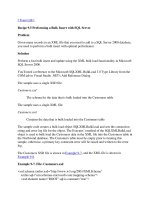Performing a Bulk Insert with SQL Server
Bạn đang xem bản rút gọn của tài liệu. Xem và tải ngay bản đầy đủ của tài liệu tại đây (16.98 KB, 5 trang )
[ Team LiB ]
Recipe 9.5 Performing a Bulk Insert with SQL Server
Problem
Given many records in an XML file that you need to add to a SQL Server 2000 database,
you need to perform a bulk insert with optimal performance.
Solution
Perform a fast bulk insert and update using the XML bulk load functionality in Microsoft
SQL Server 2000.
You'll need a reference to the Microsoft SQLXML BulkLoad 3.0 Type Library from the
COM tab in Visual Studio .NET's Add Reference Dialog.
The sample uses a single XSD file:
Customers.xsd
The schema for the data that is bulk loaded into the Customers table
The sample uses a single XML file:
Customers.xml
Contains the data that is bulk loaded into the Customers table
The sample code creates a bulk load object SQLXMLBulkLoad and sets the connection
string and error log file for the object. The Execute( ) method of the SQLXMLBulkLoad
object is used to bulk load the Customers data in the XML file into the Customers table in
the Northwind database. The Customers table must be empty prior to running this
sample, otherwise, a primary key constraint error will be raised and written to the error
log.
The Customers XSD file is shown in Example 9-7
, and the XML file is shown in
Example 9-8
.
Example 9-7. File: Customers.xsd
<xsd:schema xmlns:xsd="
xmlns:sql="urn:schemas-microsoft-com:mapping-schema">
<xsd:element name="ROOT" sql:is-constant="true">
<xsd:complexType>
<xsd:sequence>
<xsd:element ref="Customers" />
</xsd:sequence>
</xsd:complexType>
</xsd:element>
<xsd:element name="Customers" sql:relation="Customers">
<xsd:complexType>
<xsd:sequence>
<xsd:element name="CustomerID" type="xsd:string"
sql:datatype="nvarchar(5)" />
<xsd:element name="CompanyName" type="xsd:string"
sql:datatype="nvarchar(40)" />
<xsd:element name="ContactName" type="xsd:string"
sql:datatype="nvarchar(30)" />
<xsd:element name="ContactTitle"
type="xsd:string"
sql:datatype="nvarchar(30)" />
<xsd:element name="Address" type="xsd:string"
sql:datatype="nvarchar(60)" />
<xsd:element name="City" type="xsd:string"
sql:datatype="nvarchar(15)" />
<xsd:element name="Region" type="xsd:string"
sql:datatype="nvarchar(15)" />
<xsd:element name="PostalCode" type="xsd:string"
sql:datatype="nvarchar(10)" />
<xsd:element name="Country" type="xsd:string"
sql:datatype="nvarchar(15)" />
<xsd:element name="Phone" type="xsd:string"
sql:datatype="nvarchar(24)" />
<xsd:element name="Fax" type="xsd:string"
sql:datatype="nvarchar(24)" />
</xsd:sequence>
</xsd:complexType>
</xsd:element>
</xsd:schema>
Example 9-8. File: Customers.xml
<ROOT>
<Customers>
<CustomerID>ALFKI</CustomerID>
<CompanyName>Alfreds Futterkiste</CompanyName>
<ContactName>Maria Anders</ContactName>
<ContactTitle>Sales Representative</ContactTitle>
<Address>Obere Str. 57</Address>
<City>Berlin</City>
<PostalCode>12209</PostalCode>
<Country>Germany</Country>
<Phone>030-0074321</Phone>
<Fax>030-0076545</Fax>
</Customers>
<!-- . . . -->
<Customers>
<CustomerID>WOLZA</CustomerID>
<CompanyName>Wolski Zajazd</CompanyName>
<ContactName>Zbyszek Piestrzeniewicz</ContactName>
<ContactTitle>Owner</ContactTitle>
<Address>ul. Filtrowa 68</Address>
<City>Warszawa</City>
<PostalCode>01-012</PostalCode>
<Country>Poland</Country>
<Phone>(26) 642-7012</Phone>
<Fax>(26) 642-7012</Fax>
</Customers>
</ROOT>
The C# code is shown in Example 9-9
.
Example 9-9. File: BulkInsertForm.cs
// Namespaces, variables, and constants
using System;
using System.Configuration;
using System.Windows.Forms;
using SQLXMLBULKLOADLib;
using System.Data;
using System.Data.SqlClient;
private const String DATAFILENAME =
ConfigurationSettings.AppSettings["Project_Directory"] +
@"Chapter 09\Customers.xml";
private const String SCHEMAFILENAME =
ConfigurationSettings.AppSettings["Project_Directory"] +
@"Chapter 09\Customers.xsd";
private const String ERRORLOGFILENAME =
ConfigurationSettings.AppSettings["Temp_Directory"] +
"BulkLoadError.log";
// . . .
// Create the bulk load object, defining connection, and error log.
SQLXMLBulkLoad bl = new SQLXMLBulkLoad( );
bl.ConnectionString =
ConfigurationSettings.AppSettings["OleDb_Msde_ConnectString"];
bl.ErrorLogFile = ERRORLOGFILENAME;
// Execute the bulk load.
try
{
bl.Execute(SCHEMAFILENAME, DATAFILENAME);
MessageBox.Show("Bulk load completed successfully.", "Bulk Load",
MessageBoxButtons.OK, MessageBoxIcon.Information);
}
catch (Exception)
{
MessageBox.Show("ERROR. See " + ERRORLOGFILENAME + " for details.",
"Bulk Load Error", MessageBoxButtons.OK, MessageBoxIcon.Error);
}
finally
{
bl = null;
}
Discussion
The SQL Server XML Bulk Load component is used through COM interop to bulk insert
data contained in a XML document into a SQL Server database. This component controls
the execution of a XML bulk load operation. The example defines an optional error log
file, where the default is an empty string meaning that no error log is created.
You can bulk load data into multiple parent-child tables at the same time, a feature that is
not available in the OpenXML Transact-SQL extension.
For information about the XML Bulk Load component and its methods and properties,
see the topic "XML Bulk Load" in the MSDN Library.
[ Team LiB ]









